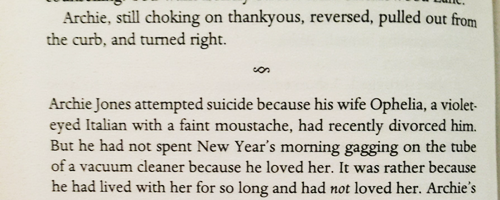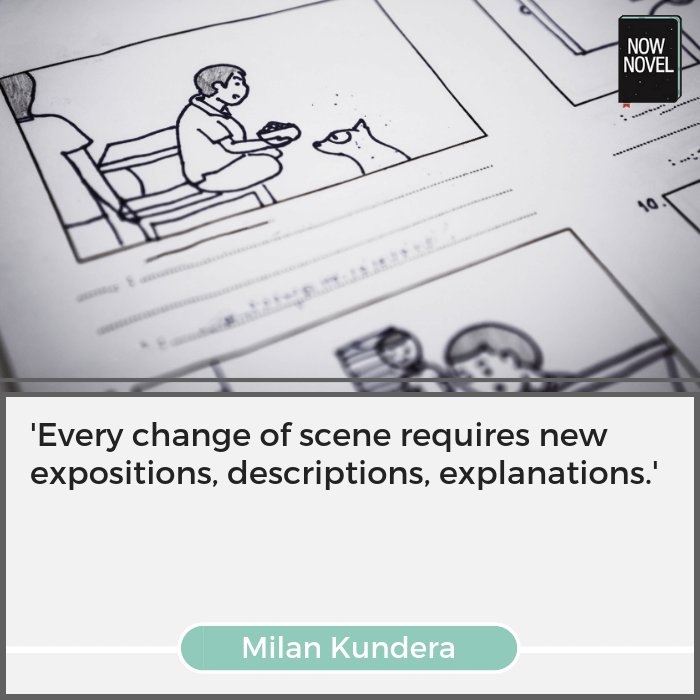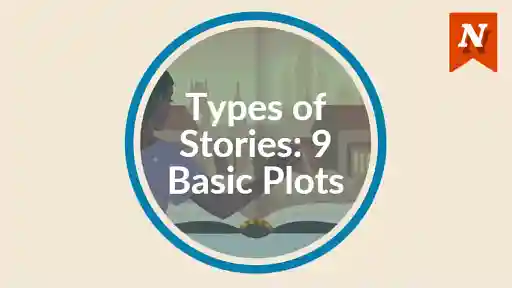Scene breaks and transitions allow us to experience different narrative time-frames and situations involving different characters in short succession. Writing good scene breaks and transitions will keep your story moving, even as you switch between settings (places and times) and viewpoints. Here's how you can use scene breaks and transitions:
1: Use scene transitions to shift between time periods
There are many ways to use scene transitions and breaks in your book.
One way to use scene transitions is to switch between present experiences and backstory.
Example of introducing backstory in a transition
Zadie Smith uses this type of scene transition effectively in her novel White Teeth (2000). In her first chapter, set in 1974 and 1945, the owner of a Halaal butchery saves Archie Jones from committing suicide in his car. The scene ends thus:
'Archie, still choking on thankyous, reversed, pulled out from the curb, and turned right.' (p. 8)
Smith follows the ending of this scene with a line break, then a symbol to mark the scene break. The most common symbol for scene breaks mid-chapter is three asterisks, ***. Hers looks like this:

The chapter shifts from current events to Archie's backstory, as Smith shares the reasons behind Archie's attempt:
'Archie Jones attempted suicide because his wife Ophelia, a violet-eyed Italian with a faint moustache, had recently divorced him.' (p. 8)
From here, the chapter heads back in time to the years after World War II. We learn the formative experiences that led Archie to this point:
'The first spring of 1946, he had stumbled out of the darkness of war and into a Florentine coffee house, where he was served by a waitress truly like the sun: Ophelia Diagilo, dressed all in yellow, spreading warmth and the promise of sex as she passed him a frothy cappuccino.' (p. 8)
Smith creates curiosity about what led Archie to this low point. She then satisfies this curiosity after a mid-chapter break by giving us history that fills in colour. Separating your time-frames this way is one way to create a rich sense of character history.
2: Use scene or chapter breaks to switch between characters' POVs
When a chapter or scene ends, and we have reached a new point in learning more about a character or their history, switching to another character's point of view is useful because:
- A POV change lets you show events from another character's perspective
- You can explore another character's intertwining life and history
- You can add variety to the events of your story by introducing new subplots
Gabriel Garcia Marquez's novel Love in the Time of Cholera (1985) begins with the death of Dr Juvenal Urbino, and proceeds to chronicle the unrequited love affair between the late Dr's widow, Fermina Daza, and one Florentino Ariza.
The first chapters of the novel give us the private histories of each of these three characters. The first chapter ends after Florentino (inappropriately, just after the Dr's funeral) declares his undying love to Fermina. The chapter ends with the widow's point of view, after all the mourners have left:
'... she began to sob in her sleep, and she slept, sobbing, without changing position on her side of the bed, until long after the rooster's crowed and she was awakened by the despised sun of the morning without him. Only then did she realize that she had slept a long time without dying, sobbing in her sleep, and that while she slept, sobbing, she had thought more about Florentino Ariza than about her dead husband.' (p. 51)
The following chapter switches to Florentino Ariza's point of view:
'Florentino Ariza, on the other hand, had not stopped thinking of her for a single moment since Fermina Daza had rejected him out of hand after a long and troubled love affair fifty-one years, nine months, and four days ago.' (p. 54)
Marquez's choice of scene break is intelligent. We see how the re-entry of Florentino into her life troubles Fermina, but we're left waiting to see what action she takes next. This way, the tension of the encounter (the question of where it will lead) is sustained until we return to Fermina's POV.
[Balance plot and character and craft interesting viewpoint characters with the help of 'How to Write Real Characters'. Includes a workbook with prompts and exercises and videos.]

3. Change settings through scene breaks and transitions
Internal chapter breaks and transitions between scenes in your stories are also good opportunities to move the action physically to a new place. In a story involving a quest or travel, small breaks can help pass over uneventful nighttime encampment, for example. We can simply cut to the next morning.
Setting changes in scene transitions thus enable you to skip over the mundane and keep events rolling.
In J.R. R. Tolkien's The Fellowship of the Ring (1954), Part 1 of his three-part fantasy epic, there are many instances where scenes or chapters end in one location and usher in new geography in the next.
At the end of the fifth chapter, a major character plummets in a mountain underpass, to his seeming death. The chapter ends thus:
'They looked back. Dark yawned the archway of the Gates under the mountain-shadow. Faint and far beneath the earth rolled the slow drum-beats: doom. A thin black smoke trailed out. Nothing else was to be seen; the dale all around was empty [...]' (p. 350)
After this scene of loss and 'doom', however, we quickly shift to the road ahead in the next chapter. The band of travelers head for 'Lothlórien,' the land of the elves:
'Alas! I fear we cannot stay here longer,' said Aragorn. He looked towards the mountains and held up his sword. [...] They rose and looked about them. Northward the dale ran up into a glen of shadows between two great arms of the mountains, above which three white peaks were shining: Celebdil, Fanuidhol, Caradhras, the Mountains of Moria.' (p. 351)
The change of setting, from the epic confrontation in the Mines of Moria to the road ahead, keeps the story's momentum. Even though a significant character is lost, Tolkien doesn't bog down the narrative with long scenes of mourning. While the preceding scene ending is appropriately gloomy and downcast, we return to action and motion quickly.
The chapter break allows us to register the enormity of the loss the party has just experienced - it gives a suitable pause.
Use Now Novel's Scene Builder tool to create and link structured scene summaries and chart a path for your story, scene by scene.










These are excellent. Transitions and breaks can be as hard to develop as tone and voice. I can't wait to share this.
Elias Mc Clellan - Almost 7 years ago
eliasmcclellan 3+
Disqus Cqm S7nz Fzm - Almost 7 years ago
Thanks, Elias! We appreciate the sharing :)
Jordan At Now Novel - Almost 7 years ago
my story's protagonist will not meet her antagonist lover until each develops in their own set up of goals and conflicts. Why or why not complete each set up in turn, protagonist then antagonist, instead of switching back and forth? Once they meet, that starts the second act.
Rob Shwab - Almost 5 years ago
Hi Rob, thank you for your interesting question. I would say alternating protagonist and antagonist's POV sections more frequently could have some benefits, with the end of one character's section having the suspense-generating effect of a cliffhanger as we wait for their section to return and learn what happens next in their arc. Another reason to maybe alternate rather than have a slab of story per character is it might seem more odd to shift viewpoint after chapters or pages of one character, as the reader might come to expect that character is the main and anyone else is secondary or a bit part. There are no 'rules', however. I'm sure you could pull off not alternating viewpoints as much. I do like the idea of their meeting starting the second act, if both characters are individually established within the first act apart from each other. If they only meet at this point, one question is what the inciting incident would be for each character? (In romantic arcs, often the inciting incident is this meeting, e.g. Romeo and Juliet for a classic exmaple). I hope this is helpful to you!
Jordan - Almost 5 years ago
Very helpful! My key takeaway from your reply is to leave the scene of one character with the 'cliffhanger' so we are eager to return to her, and vice versa.
Rob Shwab - Almost 5 years ago